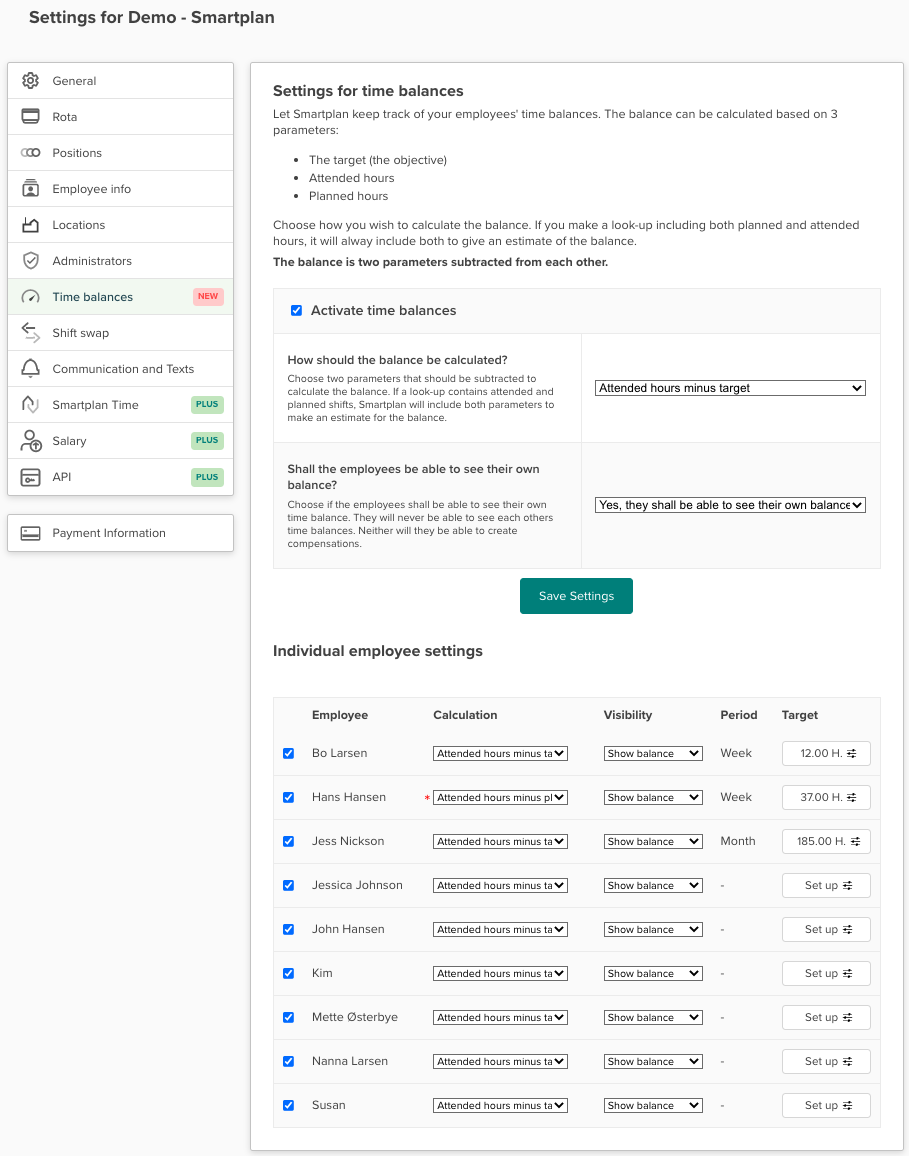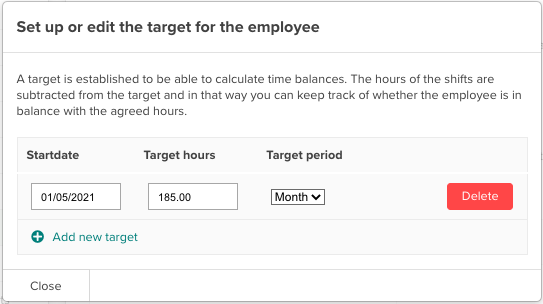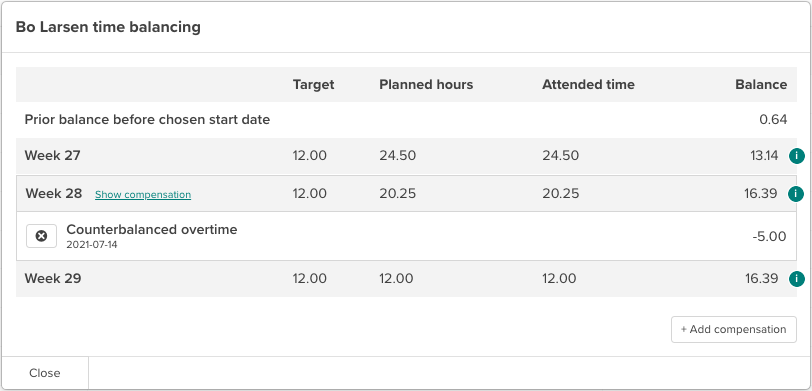New in Smartplan: Time balances
Shortly before the summer vacation we told that we were working on a new feature and now, we can finally announce that the feature has been launched! So from today, it is possible for you to get an overview of your employees’ time balances in Smartplan. Let us take a look at it.
What are time balances in Smartplan?
Time balances make it possible for you to keep track of whether your employees’ are following your wanted target regarding, how many hours they should work - either per week or per month.
This provides a lot of new use cases, which will make it easier for you to plan to employees correctly in your shiftplanning. It will for example be possible to:
- Handle some kind of flex-account in Smartplan for each employee.
- See if your hourly paid employees employee get the number of hour they are employed to in their contract.
- See if your full-time employees counterbalances the necessary overtime.
- See if you prioritize your available ressources well enough.
All of this - and more - will be possible with the new feature. And the best? You can easily get started with just a few clicks.
This is how you get started:
Set up time balances on your account
When you want to start using time balances in Smartplan you should first of all set up some preferences regarding how the calculations should be made. This can be done in “Smartplan” -> “Smartplan Settings” -> “Time balances”. The first thing is to activate the new feature on your account.
Next, you can choose a general setting regarding how the employees time balances should be calculated. Should the planned hours in the rota be used or the attended hours that the employees have had? You can either choose Planned hours minus target, Attended hours minus target or Attended hours minus planned hours.
Furthermore, you can choose whether the employees should be able to see their own time balances or not.

Beneath the general settings, you can set up more specific settings for each employee. In the column to the left, you will find all the employees that has been created on your account, and for each employee you can then choose the following:
- Calculation
- Visibility
- Period
- Target
Calculation and visibility are the same options as under the general settings. So here you can simply change it if certain employees should have a different set up from what you have chosen as the general setting on your account. If you at some point change your general settings, it will not overwrite the specific settings that you might have chosen for some employees - the specific settings will always apply.
In the column Target, you set up the concrete target for your employees which is what you employees are employed to work. When you are adding a target, you have to choose a start date. You have to fill out the number of hours, that the employees time balance should be calculated based on and finally, you have to choose if it should be calculated on a monthly or weekly basis.

You have to set up a target no matter how you have chosen that the employee’s balance should be calculated. So even though you have chosen Attended hours minus planned hours, you still have to set up a target, but this amount of hours will not be used in the calculation.
If your employees targets at some point changes, this is also where you can add a new one. Simply click on “Add new target”. This might be relevant if an employee’s contract is change and that person should now work more or less than before. In that case, you simply add a new target for the employee.
Your settings will of course be saved so that you only have to set it up for each employee once - and then maybe adjust at a later point, if the employee’s target should change.
Calculation of the employees’ time balances
Not much has changed regarding how we imagined your overview of the employees time balances would be before summer vacation. In “Hours & Salary”, you can always keep an eye on what the time balances are for a certain period.

When you click on the number in the column “Balance”, you will be able to see how the employee’s time balance has been calculated. The balance for one period will automatically be transferred to the following period.
On the screenshot below, you can see that a compensation has been added in week 28 as the employees has counterbalanced overtime. So if your employees have worked more than planned, you can add a compensation to their balance which will then be deducted. Compensations can have both a positive and negative value and you also give them a name yourself. So you can adjust them to your specific needs.

Frequently asked questions
A couple of questions might be relevant for you regarding how the balances are calculated, so we will just go through these.
“I have chosen that employee’s target should be calculated on a monthly basis. What happens if I make a look-up for a month and a half?”
If you have chosen that the employee’s target should be calculated on a monthly basis, all of the months in your look-up will be included in the calculation of the balance.
This means that if you for example have made a look-up from August 16th to September 30th, all of August and all of September will be included in the calculation of the employee’s time balance.
Similar, if you make a look-up from August 16th to October 15th, all of August, September and October will be included in the calculation. So no matter which look up you make, the time balance will include all of the months in their full length.
“I have chosen that my employee’s target should be calculated on a weekly basis. What happens if I make a look-up for a week and a half?”
In this case, the answer is the same as above. The weeks in your look-up will be included in their full length in the calculation of the time balance.
This means that if your look-up starts Thursday in week 34 and ends Sunday in week 35, all of week 34 and 35 will be included in the calculation of the time balance.
“The setting for one of my employees is ‘Attended hours minus target’. What happens if I make a look-up that contains hours that are not yet attended?”
If you have chosen that the employee’s time balance should be calculated based on attendance, it will primarily be the attended hours that the calculation is based on. However, if you make a look-up that contains not yet attended hours, the planned hours will instead be included in the time balance for these shifts.
This means that if you make a look-up on August 31st for the period August 1st to September 30th, it will be the attended hours that the balance is based on for the month of August. But it will be the planned hours that the balance is based on for the month of September.
“Can I add my employees’ current balances to Smartplan?”
Yes. If you already have a sheet with your employees’ balances, you can simply add the current balances as a compensation for each employee when you start using time balances in Smartplan. This way you do not have to start over.
“Can we use Smartplan’s time balances for shifts in the past?”
Yes. The balance is based on the start date that you set for the employee’s first target. So if you want Smartplan to calculate the time balance from the beginning of this year, you simply add a target for the employee that starts on January 1st 2021.
This new feature is available to all of our customers so it is not necessary to have purchased Smartplan Plus. If you have any questions about the feature, please do not hesitate to reach out. You can contact us in the chat or on support@trysmartplan.com.
Smartplan is a perfect match for your business
It’s easy to switch
Whether you’re currently using scheduling software, Excel or even a pen and paper, switching to Smartplan is quick and easy.
It just works
Smartplan combines a simple, user-friendly interface and powerful scheduling tools to create a system that just works.
Take care of your bottom line
We’ve ditched unnecessary frills and functions to give you the most cost-effective solution.